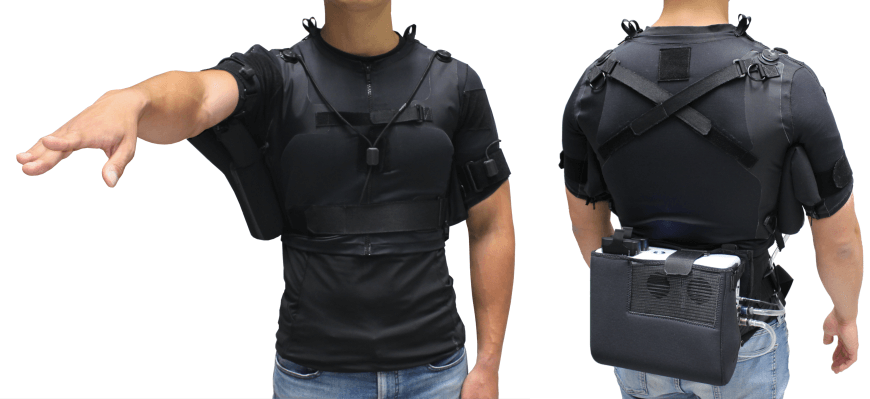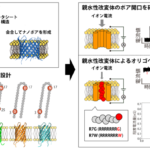快適性、安全性、使いやすさを追求した実証機 Proof-of-concept device is comfortable, safe, easy to use
2023-02-03 ハーバード大学
 This soft robotic wearable is capable of significantly assisting upper arm and shoulder movement in people with ALS. (Photo credit: Walsh Lab, Harvard SEAS)
This soft robotic wearable is capable of significantly assisting upper arm and shoulder movement in people with ALS. (Photo credit: Walsh Lab, Harvard SEAS)
◆このたび、ハーバード大学ジョン・A・ポールソン工学応用科学大学院(SEAS)とマサチューセッツ総合病院(MGH)の研究チームが、ALS患者の上腕と肩の動きを大幅に補助できるソフトロボット型のウェアラブルを開発しました。
◆「この研究は、ALSやその他の運動能力を奪われる病気の患者さんの手足の機能を回復させる新しいデバイスの開発に役立つかもしれないという希望を与えてくれます」と、このチームの研究を報告したScience Translational Medicine論文のシニア著者であるConor Walsh氏は述べています。ウォルシュ教授は、ハーバード大学バイオデザイン研究所のポール・A・メイダー工学・応用科学教授を務めている。
◆この試作品は、柔らかい布製で、バッテリーによってコードレスで作動する。
◆論文の筆頭著者で、このウェアラブルを設計・製造したウォルシュの研究室の元博士研究員であるトマソ・プロイエッティは、「この技術は本質的に非常にシンプルです」と言います。「基本的にはシャツで、脇の下には膨らませることのできる風船のようなアクチュエーターがいくつか付いています。加圧されたバルーンは、着用者が重力に対抗して上腕と肩を動かすのを助ける。”
◆ALS患者を支援するために、研究チームは、腕の残留運動を検出するセンサーシステムを開発し、その人の腕をスムーズかつ自然に動かすために、バルーンアクチュエータの適切な加圧を較正している。研究チームは、ALS患者10人を対象に、この装置がどの程度、患者の動作や生活の質を向上させ、回復させることができるかを評価した。
◆その結果、このソフトロボット型ウェアラブルは、装着者それぞれの運動能力や筋力のレベルを検出するための30秒間のキャリブレーションを経て、被験者の可動域を広げ、筋肉疲労を軽減し、物を持ったり手を伸ばすといったタスクの遂行能力を向上させることが分かりました。参加者は、15分以内にデバイスの使い方を習得することができました。
◆「このシステムは、布と風船でできているので、本質的な安全性も高いのです。「従来の硬いロボットとは異なり、ソフトロボットが故障すると、風船が膨らまなくなるだけのことです。しかし、着用者がロボットによって怪我をする危険はありません。”
◆ALS用に開発された現在のプロトタイプは、肩の部分にまだ動きが残っている研究参加者にしか機能しないものだった。しかし、ALSは通常2~5年で急速に進行し、患者は動くことができなくなり、最終的には話すことも飲み込むこともできなくなります。研究チームは、BrainGate神経インターフェースシステムの研究責任者であるMGH神経科医リー・ホッホバーグと共同で、脳内信号によって動作が制御される補助装着具の可能性を探っている。このようなデバイスがあれば、筋肉が動かなくなった患者さんの動きを助けることができるかもしれないと、彼らは期待しています。
<関連情報>
- https://seas.harvard.edu/news/2023/02/soft-robotic-wearable-restores-arm-function-people-als
- https://www.science.org/doi/abs/10.1126/scitranslmed.add1504?af=R
筋萎縮性側索硬化症患者に対するソフトロボット・ウェアラブルによる腕の機能回復 Restoring arm function with a soft robotic wearable for individuals with amyotrophic lateral sclerosis
Tommaso Proietti ,Ciaran O’Neill ,Lucas Gerez ,Tazzy Cole,Sarah Mendelowitz,Kristin Nuckols,Cameron Hohimer ,David Lin ,Sabrina Paganoni ,Conor Walsh
Science Translational Medicine Published:1 Feb 2023
DOI:https://doi.org/10.1126/scitranslmed.add1504
Abstract
Despite promising results in the rehabilitation field, it remains unclear whether upper limb robotic wearables, e.g., for people with physical impairments resulting from neurodegenerative disease, can be made portable and suitable for everyday use. We present a lightweight, fully portable, textile-based, soft inflatable wearable robot for shoulder elevation assistance that provides dynamic active support to the upper limbs. The technology is mechanically transparent when unpowered, can quantitatively assess free movement of the user, and adds only 150 grams of weight to each upper limb. In 10 individuals with amyotrophic lateral sclerosis (ALS) with different degrees of neuromuscular impairment, we demonstrated immediate improvement in the active range of motion and compensation for continuing physical deterioration in two individuals with ALS over 6 months. Along with improvements in movement, we show that this robotic wearable can improve functional activity without any training, restoring performance of basic activities of daily living. In addition, a reduction in shoulder muscle activity and perceived muscular exertion, coupled with increased endurance for holding objects, highlight the potential of this device to mitigate the impact of muscular fatigue for patients with ALS. These results represent a further step toward everyday use of assistive, soft, robotic wearables for the upper limbs.
A soft robotic wearable lends the shoulder a hand
Developing upper limb soft robotic wearables for people with physical impairments is still in its infancy. Here, Proietti et al. highlight a soft, lightweight, portable robotic wearableto assist shoulder movements. They test their device in ten individuals with the neurodegenerative disease amyotrophic lateral sclerosis, who had different degrees of limb impairment. Participants with the robotic wearable powered on showed improvements in the shoulder’s range of motion while undertaking tasks simulating activities of daily living. This device reduced shoulder muscle activity and perceived muscular exertion and increased endurance. This device is a step forward in the development of soft robotic wearables for everyday use.—OMS


